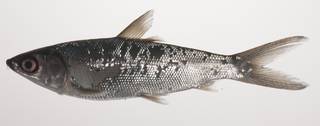
| About | | Search taxa | | Taxon tree | | Search literature | | Checklist | | Stats | | Log in |
PeRMS taxon detailsChanos chanos (Fabricius, 1775)
217625 (urn:lsid:marinespecies.org:taxname:217625)
accepted
Species
marine, brackish, fresh,
(of ) Forskål P. (1775). Descriptiones Animalium, Avium, Amphibiorum, Piscium, Insectorum, Vermium; quae in Itinere Orientali Observavit Petrus Forskål. Post Mortem Auctoris editit Carsten Niebuhr. Adjuncta est materia Medica Kahirina. Mölleri, Hafniae, 19 + xxxiv + 164 pp. , available online at https://www.biodiversitylibrary.org/page/2088059
page(s): 74, xiv [details]
Description Adults occur in small to large schools near the coasts or around islands where reefs are well developed. Eggs and larvae...
Description Adults occur in small to large schools near the coasts or around islands where reefs are well developed. Eggs and larvae are pelagic up to 2-3 weeks. Older larvae migrate onshore and settle in coastal wetlands (mangroves, estuaries) during the juvenile stage, or occasionally enter freshwater lakes. Juveniles and subadults return to sea where they mature sexually. Spawns only in fully saline water. Larvae eat zooplankton; juveniles and adults eat cyanobacteria, soft algae, small benthic invertebrates, and even pelagic fish eggs and larvae. Larvae are collected from rivers and are grown in culture ponds into juveniles, which are marketed fresh, smoked, canned and frozen. Broodstocks can be raised and spawned in captivity to produce larvae in the hatchery (Ref. 9815). Can thrive and grow in water as hot as 32° C (Ref. 9987). [details]
Froese, R. and D. Pauly. Editors. (2025). FishBase. Chanos chanos (Fabricius, 1775). Accessed through: Santamaría, J.; Romero, C.; Meza, M. (Eds) (2025) Peruvian Register of Marine Species at: https://marinespecies.org/Perms/aphia.php?p=taxdetails&id=217625 on 2025-06-09
Santamaría, J.; Romero, C.; Meza, M. (Eds) (2025). Peruvian Register of Marine Species. Chanos chanos (Fabricius, 1775). Accessed at: https://www.marinespecies.org/Perms/aphia.php?p=taxdetails&id=217625 on 2025-06-09
Date action by
original description
(of ) Forskål P. (1775). Descriptiones Animalium, Avium, Amphibiorum, Piscium, Insectorum, Vermium; quae in Itinere Orientali Observavit Petrus Forskål. Post Mortem Auctoris editit Carsten Niebuhr. Adjuncta est materia Medica Kahirina. Mölleri, Hafniae, 19 + xxxiv + 164 pp. , available online at https://www.biodiversitylibrary.org/page/2088059
page(s): 74, xiv [details] context source (Introduced species) Katsanevakis, S.; Bogucarskis, K.; Gatto, F.; Vandekerkhove, J.; Deriu, I.; Cardoso A.S. (2012). Building the European Alien Species Information Network (EASIN): a novel approach for the exploration of distributed alien species data. <em>BioInvasions Records.</em> 1: 235-245., available online at http://easin.jrc.ec.europa.eu [details] Available for editors context source (HKRMS) Hong Kong marine fish database. <em>AFCD.</em> , available online at https://www.hk-fish.net/en/fish/introduction/ [details] context source (RAS) Australian Antarctic Data Centre. , available online at https://data.aad.gov.au/aadc/biodiversity/ [details] context source (PeRMS) Chirichigno, N.; Cornejo, M. (2001). Catálogo comentado de los peces marinos del Perú. <em>2ª ed. Instituto del Mar de Perú. Publicación Especial. Callao.</em> 314 p. [details] basis of record Froese, R. & D. Pauly (Editors). (2025). FishBase. World Wide Web electronic publication. version (06/2024)., available online at https://www.fishbase.org [details] additional source Liu, J.Y. [Ruiyu] (ed.). (2008). Checklist of marine biota of China seas. <em>China Science Press.</em> 1267 pp. (look up in IMIS) [details] Available for editors additional source Zenetos, A., Gofas, S., Morri, C., Rosso, A, Violanti, D., Garcia Raso, J. E., Cinar, M. E., Almogi-Labin, A., Ates, A. S., Azzurro, E., Ballesteros, E., Bianchi, C. N., Bilecenoglu, M., Gambi, M. C., Giangrande, A., Gravili, C., Hyams-Kaphzan, O., Karachle, P. K., Katsanevakis, S., Lipej, L., Mastrototaro, F., Mineur, F., Pancucci-Papadopoulou, M. A., Ramos Espla, A., Salas, C., San Martin, G., Sfriso, A., Streftaris, N., and Verlaque, M. (2012). Alien species in the Mediterranean Sea by 2012. A contribution to the application of European Union's Marine Strategy Framework Directive (MSFD). Part 2. Introduction trends and pathways. <em>Mediterranean Marine Science.</em> 13(2): 328-352. [details] Available for editors ecology source Looby, A.; Erbe, C.; Bravo, S.; Cox, K.; Davies, H. L.; Di Iorio, L.; Jézéquel, Y.; Juanes, F.; Martin, C. W.; Mooney, T. A.; Radford, C.; Reynolds, L. K.; Rice, A. N.; Riera, A.; Rountree, R.; Spriel, B.; Stanley, J.; Vela, S.; Parsons, M. J. G. (2023). Global inventory of species categorized by known underwater sonifery. <em>Scientific Data.</em> 10(1). (look up in IMIS), available online at https://doi.org/10.1038/s41597-023-02745-4 [details]  Present Present  Inaccurate Inaccurate  Introduced: alien Introduced: alien  Containing type locality Containing type locality
From regional or thematic species database
Introduced species vector dispersal in Turkish part of the Mediterranean Sea - Eastern Basi (Marine Region) : Fisheries: deliberate translocations of fish or shellfish to establish or support fishery [details]Unreviewed
Description Adults occur in small to large schools near the coasts or around islands where reefs are well developed. Eggs and larvae are pelagic up to 2-3 weeks. Older larvae migrate onshore and settle in coastal wetlands (mangroves, estuaries) during the juvenile stage, or occasionally enter freshwater lakes. Juveniles and subadults return to sea where they mature sexually. Spawns only in fully saline water. Larvae eat zooplankton; juveniles and adults eat cyanobacteria, soft algae, small benthic invertebrates, and even pelagic fish eggs and larvae. Larvae are collected from rivers and are grown in culture ponds into juveniles, which are marketed fresh, smoked, canned and frozen. Broodstocks can be raised and spawned in captivity to produce larvae in the hatchery (Ref. 9815). Can thrive and grow in water as hot as 32° C (Ref. 9987). [details]
To Barcode of Life (217 barcodes)
To Biodiversity Heritage Library (142 publications) To Biological Information System for Marine Life (BISMaL) To European Nucleotide Archive, ENA (Chanos chanos) To FAO Cultured Aquatic species fact sheets To FishBase To FishBase images (Chanos chanos, Sudan, by Randall, J.E.) To GenBank (37776 nucleotides; 32075 proteins) To Global Biotic Interactions (GloBI) To IUCN Red List (Least Concern) To NMNH Extant Collection (Chanos chanos USNM 403160 photograph lateral view) To NMNH Extant Collection (Chanos chanos USNM 435471 photograph lateral view) To ITIS |



